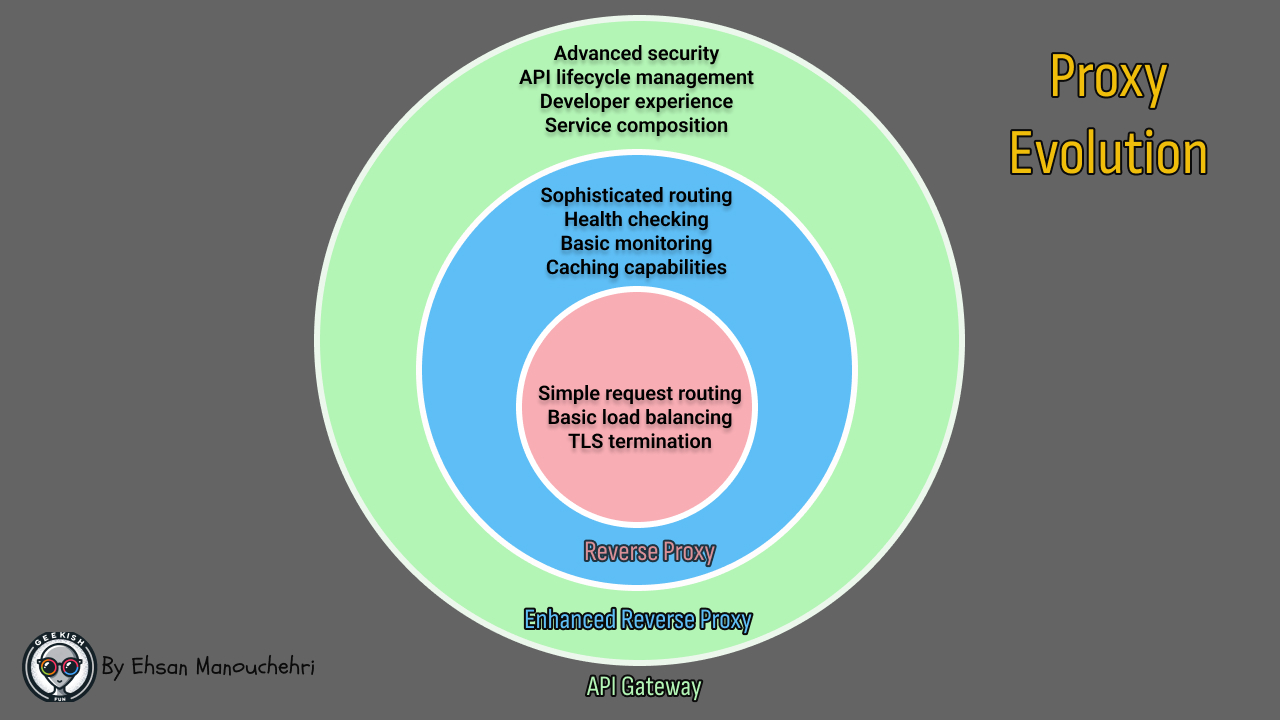Reverse Proxies in Microservice Architecture

Exploring the evolution of reverse proxies from basic routing to full-featured API gateways, including key patterns and decision frameworks for microservice architectures
Published on January 07, 2025 by Ehsan Manouchehri
Microservices ReverseProxy APIGateway ServiceMesh SystemDesign DistributedSystems CloudNative Kubernetes LoadBalancing ServiceDiscovery CircuitBreaking Resilience
2 min READ
Introduction
In modern microservice architectures, reverse proxies serve as a foundational building block, evolving from simple request forwarders to sophisticated API gateways. Understanding this evolution and the distinct roles is crucial for building effective microservice systems.
The Evolution Journey
1. Basic Reverse Proxy
The foundation of microservice communication:
- Simple request routing
- Basic load balancing
- TLS termination
2. Enhanced Reverse Proxy
As services grow:
- Sophisticated routing
- Health checking
- Basic monitoring
- Caching capabilities
3. API Gateway
The mature platform:
- Advanced security
- API lifecycle management
- Developer experience
- Service composition

Why This Matters in Microservices
1. Service Communication
- Central entry point
- Protocol translation
- Service discovery
- Load distribution
2. Security and Control
- Authentication point
- Rate limiting
- Traffic monitoring
- Access control
3. Developer Experience
- API documentation
- Service composition
- Versioning
- Analytics
Key Patterns
As reverse proxies evolved from basic routing to full-featured API gateways, certain patterns emerged as battle-tested solutions to recurring challenges. These patterns represent collective wisdom from countless implementations across the industry, offering proven approaches to common problems. Rather than reinventing solutions (because seriously, who has time to rediscover fire? Been there, rebuilt that, got the debugging scars), teams can leverage these established patterns to build more reliable and maintainable systems.
The following patterns have become fundamental building blocks in reverse proxy implementations, with different patterns becoming relevant at each stage of proxy evolution:
1. Gateway Patterns
- Backend for Frontend (BFF)
- Aggregate APIs
- Protocol Translation
- Service Mesh Integration
2. Resilience Patterns
- Circuit Breaking
- Retry Mechanisms
- Rate Limiting
- Fallback Responses
3. Security Patterns
- Authentication
- Authorization
- API Key Management
- Traffic Filtering
Common Use Cases
1. Service Transition
- Monolith decomposition
- Legacy system integration
- Gradual modernization
2. Traffic Management
- A/B testing
- Canary releases
- Blue-green deployments
- Traffic shadowing
3. API Management
- Version management
- Documentation
- Analytics
- Developer portals
Decision Framework
When to Start Simple
- Small team
- Few services
- Basic routing needs
- Internal-only services
When to Enhance
- Multiple environments
- Growing service count
- Need for monitoring
- Basic security requirements
When to Implement Full Gateway
- Multiple teams
- Public APIs
- Complex security needs
- Service composition requirements
Looking Ahead
This post is part of a series exploring microservice patterns. Future posts will dive deep into:
- API Gateway Patterns
- Service Mesh Implementation
- Security Patterns
- Resilience Strategies
- Monitoring and Observability
Conclusion
Understanding the evolution and role of proxies and gateways is crucial for building effective microservice architectures. Start simple, evolve as needed, and choose the right level of sophistication for your specific use case.